tow TOYOTA T100 1997 User Guide
[x] Cancel search | Manufacturer: TOYOTA, Model Year: 1997, Model line: T100, Model: TOYOTA T100 1997Pages: 212, PDF Size: 3.17 MB
Page 64 of 212
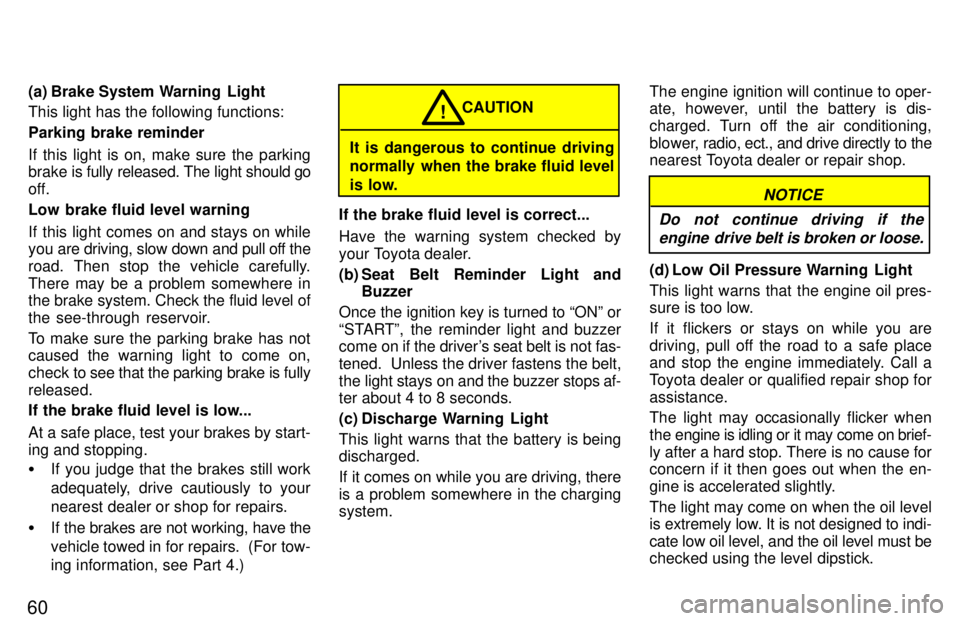
60(a) Brake System Warning Light This light has the following functions: Parking brake reminder
If this light is on, make sure the parking
brake is
fully released. The light should go
off.
Low brake fluid level warning
If this light comes on and stays on while
you are driving, slow down and pull off the
road. Then stop the vehicle carefully.There may be a problem somewhere in
the brake system. Check the fluid level of
the see-through reservoir.
To make sure the parking brake has not
caused the warning light to come on,
check to see that the parking brake is fully
released.
If the brake fluid level is low...
At a safe place, test your brakes by start-
ing and stopping. � If you judge that the brakes still work
adequately, drive cautiously to yournearest dealer or shop for repairs.
� If the brakes are not working, have the
vehicle towed in for repairs. (For tow-
ing information, see Part 4.)
It is dangerous to continue driving
normally when the brake fluid level
is low. CAUTION
!
If the brake fluid level is correct...
Have the warning system checked by
your Toyota dealer.
(b) Seat Belt Reminder Light and Buzzer
Once the ignition key is turned to ONº or
STARTº, the reminder light and buzzer
come on if the driver's seat belt is not fas- tened. Unless the driver fastens the belt,
the light stays on and the buzzer stops af-
ter about 4 to 8 seconds.
(c) Discharge Warning Light
This light warns that the battery is being discharged.
If it comes on while you are driving, there
is a problem somewhere in the charging system. The engine ignition will continue to oper-
ate, however, until the battery is dis-
charged. Turn off the air conditioning,
blower, ra
dio, ect., and drive directly to the
nearest Toyota dealer or repair shop.
NOTICE
Do not continue driving if the engine drive belt is broken or loose.
(d) Low Oil Pressure Warning Light
This light warns that the engine oil pres-
sure is too low.
If it flickers or stays on while you are
driving, pull off the road to a safe place
and stop the engine immediately. Call a
Toyota dealer or qualified repair shop forassistance.
The light may occasionally flicker when
the engine is idling or it may come on brief-
ly after a hard stop. There is no cause for concern if it then goes out when the en-
gine is accelerated slightly.
The light may come on when the oil level
is extremely low. It is not designed to indi- cate low oil level, and the oil level must be checked using the level dipstick.
Page 69 of 212
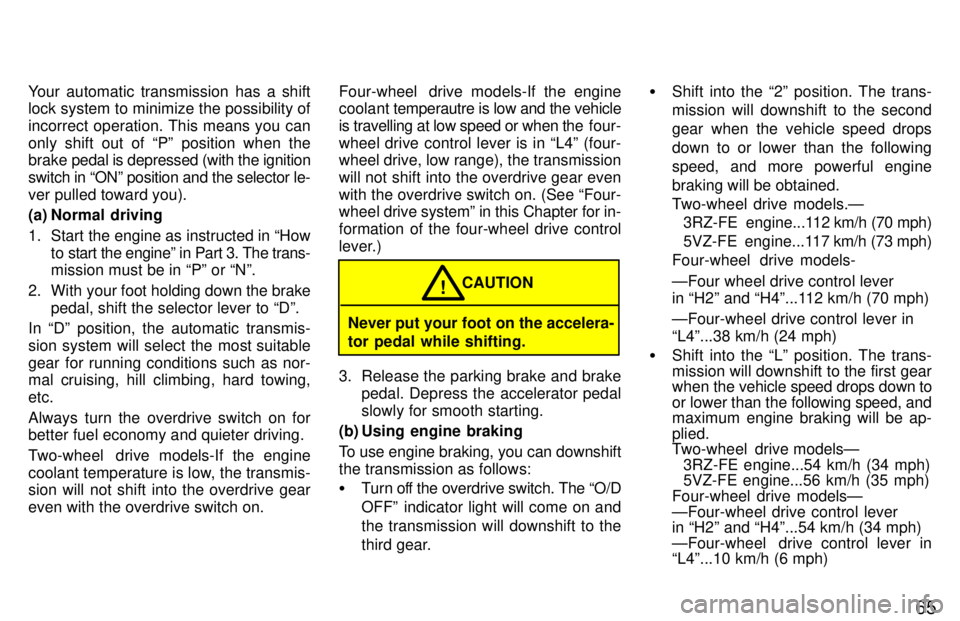
65
Your automatic transmission has a shift
lock system to minimize the possibility of
incorrect operation. This means you can
only shift out of Pº position when the brake
pedal is depressed (with the ignition
switch in ONº position and the selector le- ver pulled toward you).
(a) Normal driving
1. Start the engine as instructed in How to start the engineº in Part 3. The trans- mission must be in Pº or Nº.
2. With your foot holding down the brake pedal, shift the selector lever to Dº.
In Dº position, the automatic transmis-
sion system will select the most suitable
gear for running conditions such as nor-
mal cruising, hill climbing, hard towing, etc.
Always turn the overdrive switch on for
better fuel economy and quieter driving.
Two-wheel drive models-If the engine
coolant temperature is low, the transmis-
sion will not shift into the overdrive gear
even with the overdrive switch on. Four-wheel drive models-If the engine
coolant t
emperautre is low and the vehicle
is travelling at low speed or when the four-
wheel drive control lever is in L4º (four-
wheel drive, low range), the transmission
will not shift into the overdrive gear evenwith the overdrive switch on. (See Four-
wheel drive systemº in this Chapter for in-
formation of the four-wheel drive control
lever.)
Never put your foot on the accelera-
tor pedal while shifting. CAUTION
!
3. Release the parking brake and brake pedal. Depress the accelerator pedal
slowly for smooth starting.
(b) Using engine braking
To use engine braking, you can downshift the transmission as follows: � Turn off the overdrive switch. The O/D
OFFº indicator light will come on andthe transmission will downshift to the
third gear. �
Shift into the 2º position. The trans-
mission will downshift to the second
gear when the vehicle speed dropsdown to or lower than the followingspeed, and more powerful engine
braking will be obtained.
Two-wheel drive models.Ð
3RZ-FE engine...112 km/h (70 mph)
5VZ-FE engine...117 km/h (73 mph)
Four-wheel drive models- ÐFour wheel drive control lever
in H2º and H4º...112 km/h (70 mph) ÐFour-wheel drive control lever in L4º...38 km/h (24 mph)
� Shift into the Lº position. The trans- mission will downshift to the first gear
when the vehicle speed drops down to
or lower than the following speed, and
maximum engine braking will be ap- plied.
Two-wheel drive modelsÐ 3RZ-FE engine...54 km/h (34 mph)5VZ-FE engine...56 km/h (35 mph)
Four-wheel drive modelsÐ ÐFour-wheel drive control lever in H2º and H4º...54 km/h (34 mph)
ÐFour-wheel drive control lever in
L4º...10 km/h (6 mph)
Page 70 of 212
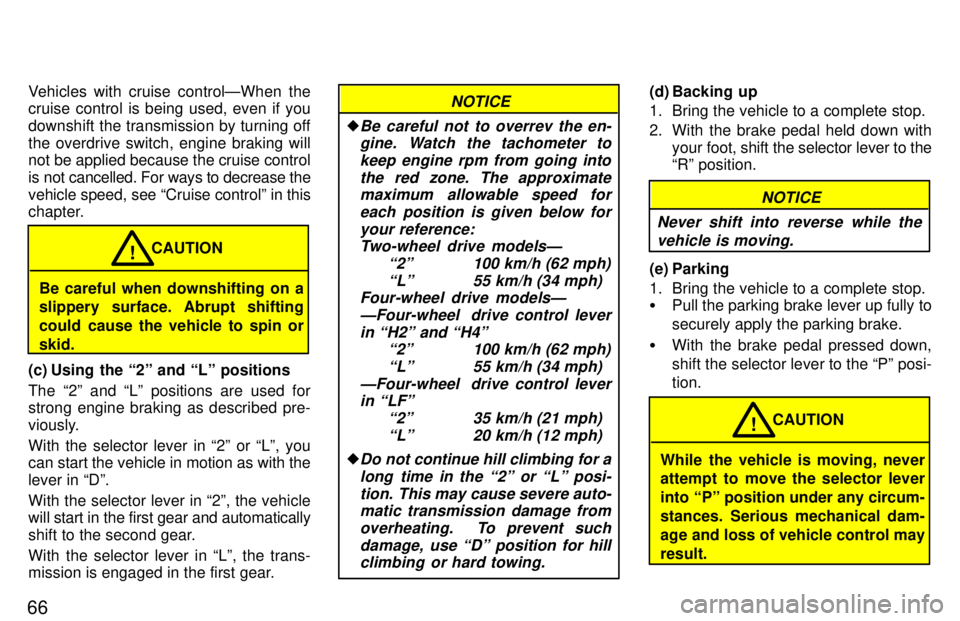
66Vehicles with cruise controlÐWhen the
cruise control is being used, even if you
downshift the transmission by turning offthe overdrive switch, engine braking will
not be applied because the cruise control
is not cancelled. For ways to decrease the
vehicle speed, see Cruise controlº in
this
chapter.
Be careful when downshifting on a
slippery surface. Abrupt shifting
could cause the vehicle to spin orskid. CAUTION
!
(c) Using the 2º and Lº positions
The 2º and Lº positions are used for
strong engine braking as described pre-
viously. With the selector lever in 2º or Lº, you
can start the vehicle in motion as with the
lever in Dº. With the selector lever in 2º, the vehicle
will start in the first gear and automatically
shift to the second gear.
With the selector lever in Lº, the trans-
mission is engaged in the first gear.
NOTICE
�Be careful not to overrev the en-
gine. Watch the tachometer to
keep engine rpm from going intothe red zone. The approximatemaximum allowable speed for
each position is given below for your reference:Two-wheel drive modelsÐ
2º 100 km/h (62 mph)Lº 55 km/h (34 mph)
Four-wheel drive modelsÐ
ÐFour-wheel drive control lever
in H2º and H4º 2º 100 km/h (62 mph)
Lº 55 km/h (34 mph)
ÐFour-wheel drive control lever in LFº
2º 35 km/h (21 mph)Lº 20 km/h (12 mph)
�Do not continue hill climbing for along time in the 2º or Lº posi-tion. This may cause severe auto-matic transmission damage from
overheating. To prevent such damage, use Dº position for hillclimbing or hard towing.
(d) Backing up
1. Bring the vehicle to a complete stop.
2. With the brake pedal held down with your foot, shift the selector lever to the
Rº position.
NOTICE
Never shift into reverse while the vehicle is moving.
(e) Parking
1. Bring the vehicle to a complete stop. � Pull the parking brake lever up fully to securely apply the parking brake.
� With the brake pedal pressed down,
shift the selector lever to the Pº posi- tion.
While the vehicle is moving, never
attempt to move the selector lever
into Pº position under any circum-
stances. Serious mechanical dam-
age and loss of vehicle control mayresult. CAUTION
!
Page 71 of 212
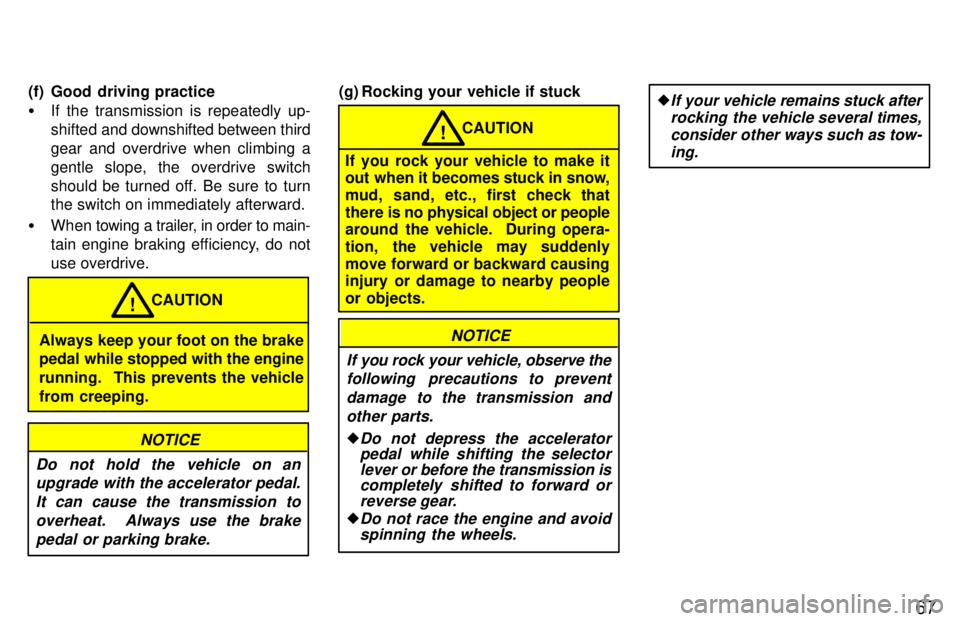
67
(f) Good driving practice �
If the transmission is repeatedly up-
shifted and downshifted between third
gear and overdrive when climbing a
gentle slope, the overdrive switch
should be turned off. Be sure to turn the switch on immediately afterward.
� When towing a trailer, in order to main-
tain engine braking efficiency, do notuse overdrive.
Always keep your foot on the brake
pedal while stopped with the engine
running. This prevents the vehicle
from creeping. CAUTION
!
NOTICE
Do not hold the vehicle on an upgrade with the accelerator pedal.
It can cause the transmission tooverheat. Always use the brake pedal or parking brake.
(g) Rocking your vehicle if stuck
If you rock your vehicle to make it
out when it becomes stuck in snow,
mud, sand, etc., first check that
there is no physical object or people
around the vehicle. During opera-
tion, the vehicle may suddenly
move forward or backward causing
injury or damage to nearby people
or objects. CAUTION
!
NOTICE
If you rock your vehicle, observe the following precautions to prevent
damage to the transmission andother parts.
�Do not depress the acceleratorpedal while shifting the selector
lever or before the transmission is
completely shifted to forward or
reverse gear.
�Do not race the engine and avoidspinning the wheels.
�If your vehicle remains stuck after
rocking the vehicle several times,
consider other ways such as tow-ing.
Page 73 of 212
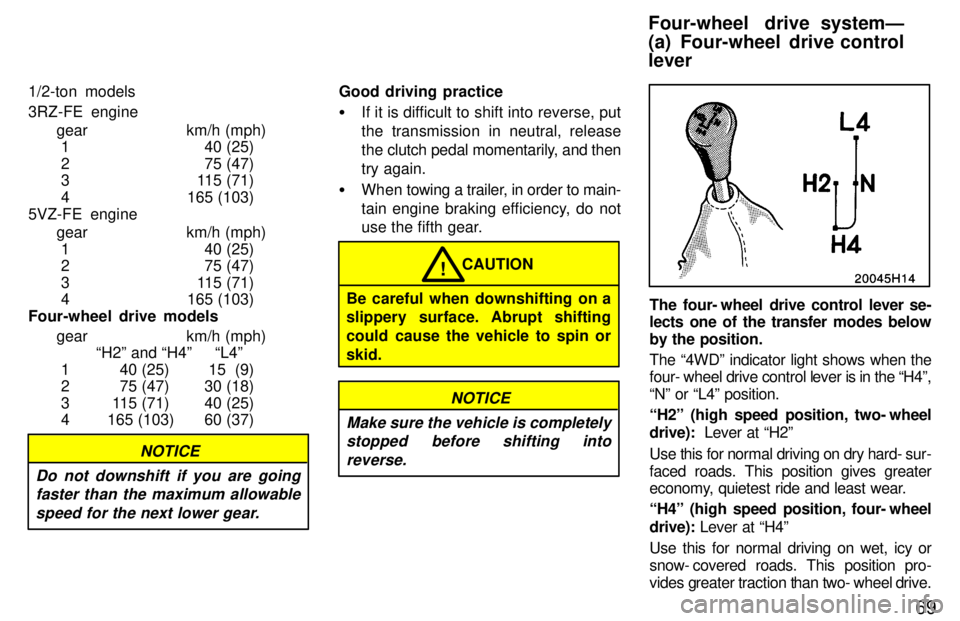
69
1/2-ton models 3RZ-FE engine
gear km/h (mph)
1 40 (25)
2 75 (47)
3 115 (71)
4 165 (103)
5VZ-FE engine
gear km/h (mph)
1 40 (25)
2 75 (47)
3 115 (71)
4 165 (103)
Four-wheel drive models
gear km/h (mph) H2º and H4º L4º
1 40 (25) 15 (9)
2 75 (47) 30 (18)
3 115 (71) 40 (25)
4 165 (103) 60 (37)
NOTICE
Do not downshift if you are going faster than the maximum allowable
speed for the next lower gear.
Good driving practice � If it is difficult to shift into reverse, put
the transmission in neutral, release
the clutch pedal momentarily, and then
try again.
� When towing a trailer, in order to main-
tain engine braking efficiency, do not
use the fifth gear.
Be careful when downshifting on a
slippery surface. Abrupt shifting
could cause the vehicle to spin orskid. CAUTION
!
NOTICE
Make sure the vehicle is completely stopped before shifting into
reverse.
The four- wheel drive control lever se-
lects one of the transfer modes below
by the position.
The 4WDº indicator light shows when the
four- wheel drive control lever is in the H4º,
Nº or L4º position.
H2º (high speed position, two- wheel
drive): Lever at H2º
Use this for normal driving on dry hard- sur-
faced roads. This position gives greater
economy, quietest ride and least wear.
H4º (high speed position, four- wheel
drive): Lever at H4º
Use this for normal driving on wet, icy or
snow- covered roads. This position pro-
vides greater traction than two- wheel drive.
Four-wheel drive systemÐ
(a) Four-wheel drive control lever
Page 105 of 212

101
Heating
For best results, set controls to:
Fan speed ÐAny setting except OFFº
Temperature Ð Towards WARM
(red zone)
Air intake ÐFRESH (outside air)
Air flow ÐFLOOR
Air conditioning ÐOFF
� For quick heating, select recirculated
air for a few minutes. To keep the win-
dows from fogging, select fresh after the vehicle interior has been warmed.
� Press the A/Cº button on for dehumid-
ified heating.
� Choose floor/windshield air flow to heat the vehicle interior while defrost-ing or defogging the windshield. Air conditioning For best results, set controls to:
Fan speed ÐAny setting except OFFº
Temperature Ð Towards COLD
(blue zone)
Air intake ÐFRESH (outside air)
Air flow ÐPANEL
Air conditioning ÐON� For quick cooling, move the air intake
selector to recirculate for a few min-utes.
Ventilation
For best results, set controls to:
Fan speed ÐAny setting except OFFº
Temperature Ð Towards COLD
(blue zone)
Air intake ÐFRESH (outside air)
Air flow ÐPANEL
Air conditioning ÐOFF
Defogging The inside of the windshield For best results, set controls to:
Fan speed ÐAny setting except OFFº
Temperature ÐTowards WARM
(red zone) to heat; COLD (blue zone) to
cool
Air intake ÐFRESH (outside air)
Air flow ÐWINDSHIELD
Vehicles withA/Cº button-
Moving the air flow selector lever to the windshield position turns on the defrost-
er-linked air conditioning. At this time, the
A/Cº button indicator comes on regard-less of whether or not the A/Cº button ispressed in. This is to clear up the front
view more quickly. When the A/Cº button is not pressed in,
turning the air flow selector lever to anoth-
er position turns off the air conditioning. � On humid days, do not blow cold air on
the windshieldÐthe difference be-tween the outside and inside tempera-
tures could make the fogging worse.
Page 106 of 212

102Defrosting The outside of the windshield For best results, set controls to:
Fan speed ÐAny setting except OFFº
Temperature Ð Towards WARM
(red zone)
Air intake ÐFRESH (outside air)
Air flow ÐWINDSHIELD
Vehicles with A/Cº buttonÐ
Moving the air flow selector to the wind-
shield position turns on the defroster-
linked air conditioning. At this time, the
A/Cº button indicator comes on regard- less of whether or not the A/Cº button ispressed in. This is to clear up the front
view more quickly. When the A/Cº button is not pressed in,
moving the air flow selector lever to anoth-
er position turns off the air conditioning. � To heat the vehicle interior while de-
frosting the windshield, choose floor/
windshield air flow.
If air flow control is not satisfactory, check the instrument panel vents. The instru-
ment panel vents may be opened or
closed as shown.
ÐInstrument panel vents
Page 111 of 212
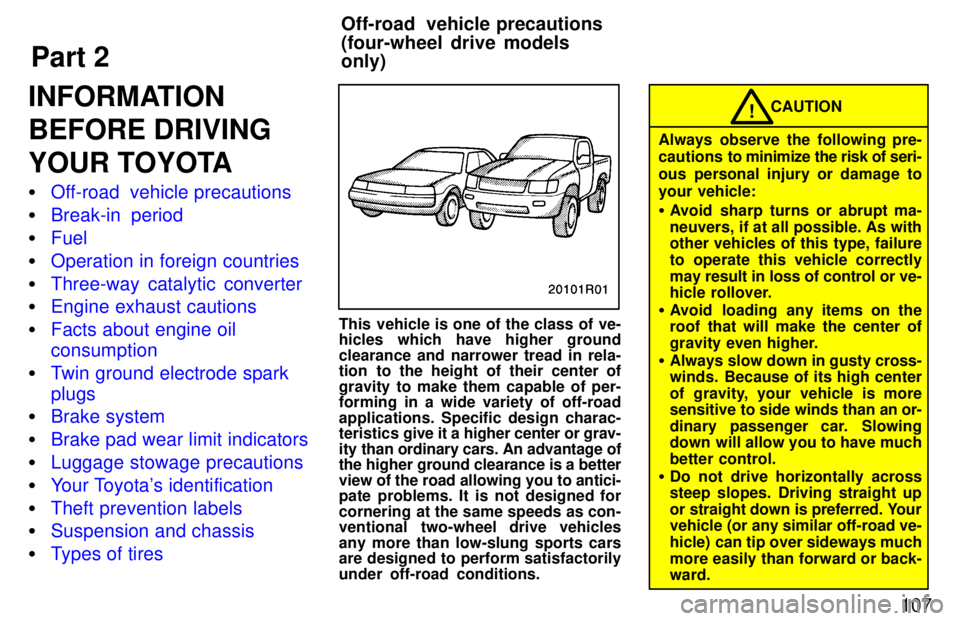
Part 2Off-road vehicle precautions (four-wheel drive models only)
107
INFORMATION
BEFORE DRIVING
YOUR TOYOTA �
Off-road vehicle precautions
�Break-in period
�Fuel
�Operation in foreign countries
�Three-way catalytic converter
�Engine exhaust cautions
�Facts about engine oil consumption
�Twin ground electrode spark plugs
�Brake system
�Brake pad wear limit indicators
�Luggage stowage precautions
�Your Toyota's identification
�Theft prevention labels
�Suspension and chassis
�Types of tires
This vehicle is one of the class of ve-
hicles which have higher ground
clearance and narrower tread in rela-
tion to the height of their center of
gravity to make them capable of per- forming in a wide variety of off-road applications. Specific design charac-
teristics give it a hi
gher center or grav-
ity than ordinary cars. An advantage ofthe higher ground clearance is a better view of the road allowing you to antici-
pate problems. It is not designed for
cornering at the same speeds as con-
ventional two-wheel drive vehicles
any more than low-slung sports cars
are designed to perform satisfactorily under off-road conditions.
CAUTION!
Always observe the following pre-
cautions to m inimize the risk of seri-
ous personal injury or damage to
your vehicle: � Avoid sharp turns or abrupt ma-
neuvers, if at all possible. As with
other vehicles of this type, failure
to operate this vehicle correctly
may result in loss of control or ve-
hicle rollover.
� Avoid loading any items on the
roof that will make the center of
gravity even higher.
� Always slow down in gusty cross-
winds. Because of its high center
of gravity, your vehicle is more
sensitive to side winds than an or-
dinary passenger car. Slowing
down will allow you to have much
better control.
� Do not drive horizontally across steep slopes. Driving straight up
or straight down is preferred. Your
vehicle (or any similar off-road ve-
hicle) can tip over sideways much
more easily than forward or back- ward.
Page 112 of 212
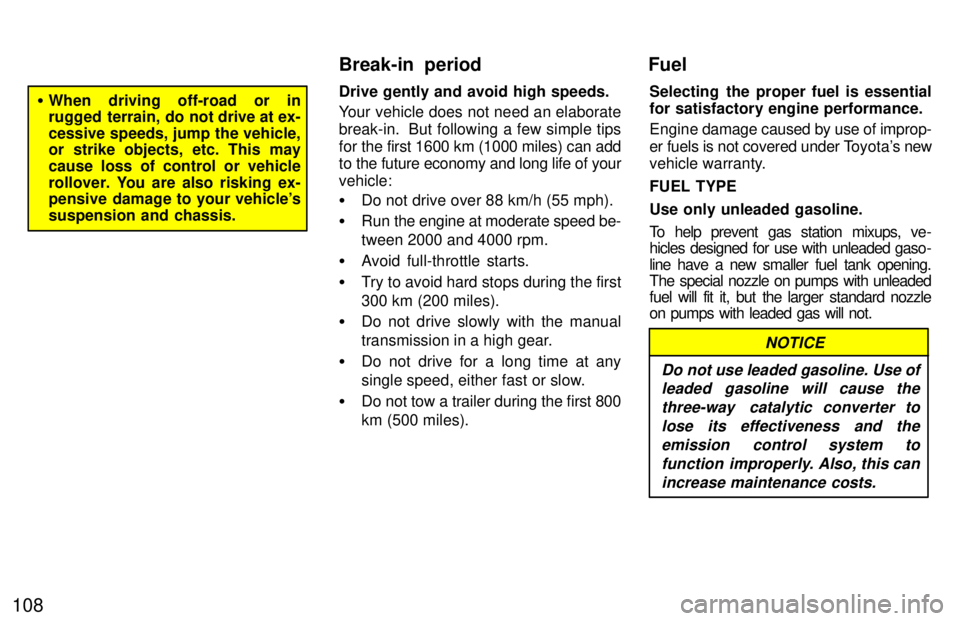
108
�When driving off-road or in
rugged terrain, do not drive at ex- cessive speeds, jump the vehicle,
or strike objects, etc. This may cause loss of control or vehicle
rollover. You are also risking ex-
pensive damage to your vehicle's suspension and chassis. Drive gently and avoid high speeds.
Your vehicle does not need an elaborate
break-in. But following a few simple tips
for the first 1600 km (1000 miles) can add
to the future economy and long life of your vehicle: �
Do not drive over 88 km/h (55 mph).
� Run the engine at moderate speed be- tween 2000 and 4000 rpm.
� Avoid full-throttle starts.
� Try to avoid hard stops during the first
300 km (200 miles).
� Do not drive slowly with the manual
transmission in a high gear.
� Do not drive for a long time at any
single speed, either fast or slow.
� Do not tow a trailer during the first 800
km (500 miles). Selecting the proper fuel is essential
for satisfactory engine performance.
Engine
damage caused by use of improp-
er fuels is not covered under T oyota's new
vehicle warranty. FUEL TYPEUse only unleaded gasoline.
To help prevent gas station mixups, ve-
hicles designed for use with unleaded gaso-
line have a new smaller fuel tank opening.
The special nozzle on pumps with unleaded
fuel will fit it, but the larger standard nozzle
on pumps with leaded gas will not.
Do not use leaded gasoline. Use of
leaded gasoline will cause the
three-way catalytic converter tolose its effectiveness and the emission control system tofunction improperly. Also, this can increase maintenance costs.
NOTICE
Break-in period Fuel
Page 120 of 212
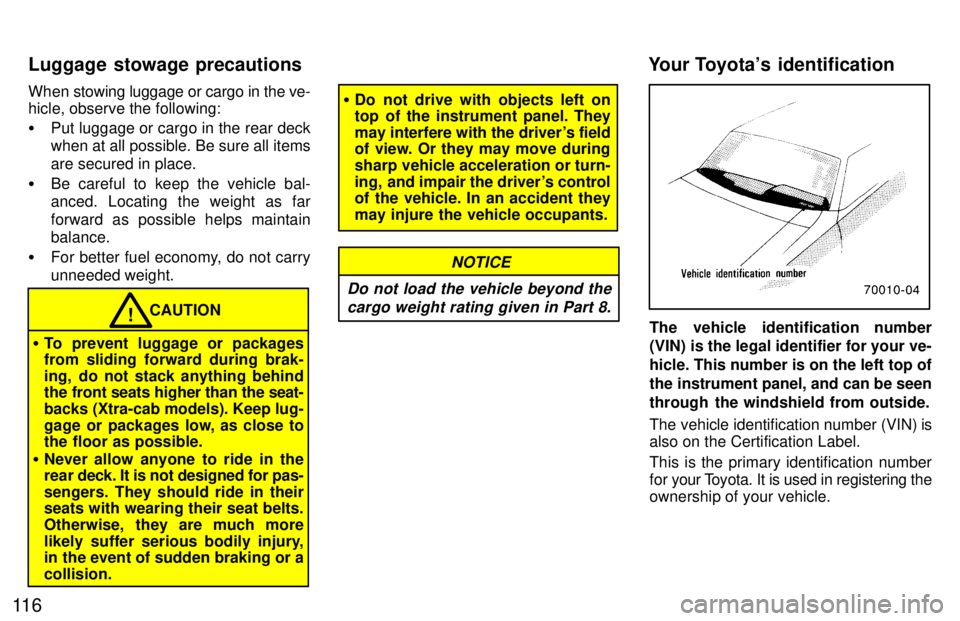
11 6When stowing luggage or cargo in the ve-
hicle, observe the following: �
Put luggage or cargo in the rear deck
when at all possible. Be sure all items are secured in place.
� Be careful to keep the vehicle bal- anced. Locating the weight as far
forward as possible helps maintain balance.
� For better fuel economy, do not carry
unneeded weight.
CAUTION!
� To prevent luggage or packages
from sliding forward during brak-
ing, do not stack anything behind
the front seats higher than the seat-
backs (Xtra-cab models). Keep lug-
gage or packages low, as close to
the floor as possible.
� Never allow anyone to ride in the
rear deck. It is not designed for pas-
sengers. They should ride in their
seats with wearing their seat belts.
Otherwise, they are much more
likely suffer serious bodily injury,
in the event of sudden braking or a collision.
� Do not drive with objects left on
top of the instrument panel. They
may interfere with the driver's field
of view. Or they may move during
sharp vehicle acceleration or turn-
ing, and impair the driver's control
of the vehicle. In an accident they
may injure the vehicle occupants.
Do not load the vehicle beyond the
cargo weight rating given in Part 8.
NOTICE
The vehicle identification number
(VIN) is the legal identifier for your ve- hicle. This number is on the left top of
the instrument panel, and can be seen
through the windshield from outside.
The vehicle identification number (VIN) is
also on the Certification Label.
This is the primary identification number
for your T oyota. It is used in registering the
ownership of your vehicle.
Luggage stowage precautions
Your Toyota's identification